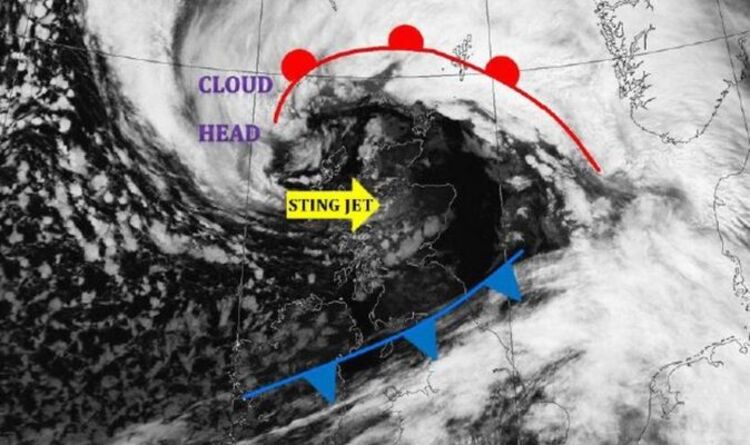Storm Eunice: Met Office issues red warning for strong winds
We use your sign-up to provide content in ways you’ve consented to and to improve our understanding of you. This may include adverts from us and 3rd parties based on our understanding. You can unsubscribe at any time. More info
According to Met Watch UK, Storm Eunice is “currently undergoing explosive cyclogenesis in the Atlantic and will likely have a Shapiro-Keyser cyclone structure as it arrives”. Apparently, this means it has a greater chance of a “sting jet” across England.
Storm Eunice is set to reach speeds of 100mph tomorrow and will cause “significant disruption” for much of the UK.
Brits are starting to get concerned about possible power outages, uprooted trees, disrupted travel, damage to homes and property and danger to life.
It’s predicted to be the worst “red warning” storm we’ve seen in 30 years and the Met Office have urged Brits to stay indoors.
There has been talk of the possibility of a ‘sting jet’ and if this happens it could be very dangerous for us all.


What is a sting jet?
A sting jet is a core of strong winds that sometimes form in rapidly deepening areas of low pressure and extends towards the ground.
To be a sting jet, the winds normally have to be at a speed of 100mph or more.
When this happens, powerful weather systems across the UK and gusts of winds can cause great damage.
Sting jets are typically narrow, about 30 miles across, and last for three to four hours.
Experts are saying this could occur between 9am and 12pm tomorrow morning in England.

Forecasting a sting jet is tricky because they’re normally quite small and the way they develop is hard to predict.
However, the Met Office explains: “There are tell-tale signs in weather models that are now able to spot cores of very strong winds.
“It is also possible to spot the sting jet developing on satellite images, as the end of the cold conveyor is marked by a hook-shaped cloud with a point at the end.
“This often looks like the sting in a scorpion’s tail, hence the name sting jet.”
There are also types of satellite images that show the amount of water vapour, made up of light and dark shades that can help to forecast a jet sting.
The Met Office site explains: “The darker the shade the less water vapour there is.
“We know that clouds are made when water vapour condenses into water droplets, but around the sting jet, there are often dark fingers of air stretching out, telling us that the rollercoaster of wind is also very dry.
“A small core of fast-moving, cold, dense, dry air.”

Storm Eunice has the potential to coincide with a sting jet, but we can’t say for sure what’s going to happen.
Met Watch UK said: “Sting jets like those require monitoring on more high res models to see if they do occur and cause that more potent disruption.
“No guarantees it will occur but one to keep a close eye on for the next 24-36 hours!”
A famous example of a sting jet is the Great Storm of 1987, which occurred in the UK, France and the Channel Islands on October 15 and 16.
During the Great Storm, at least 22 people were killed in England and France.
Forests, parks, roads and railways were strewn with fallen trees, schools were closed and the British National Grid was heavily damaged.
We could see similar disruptions tomorrow if the sting jet does develop.
Source: Read Full Article
